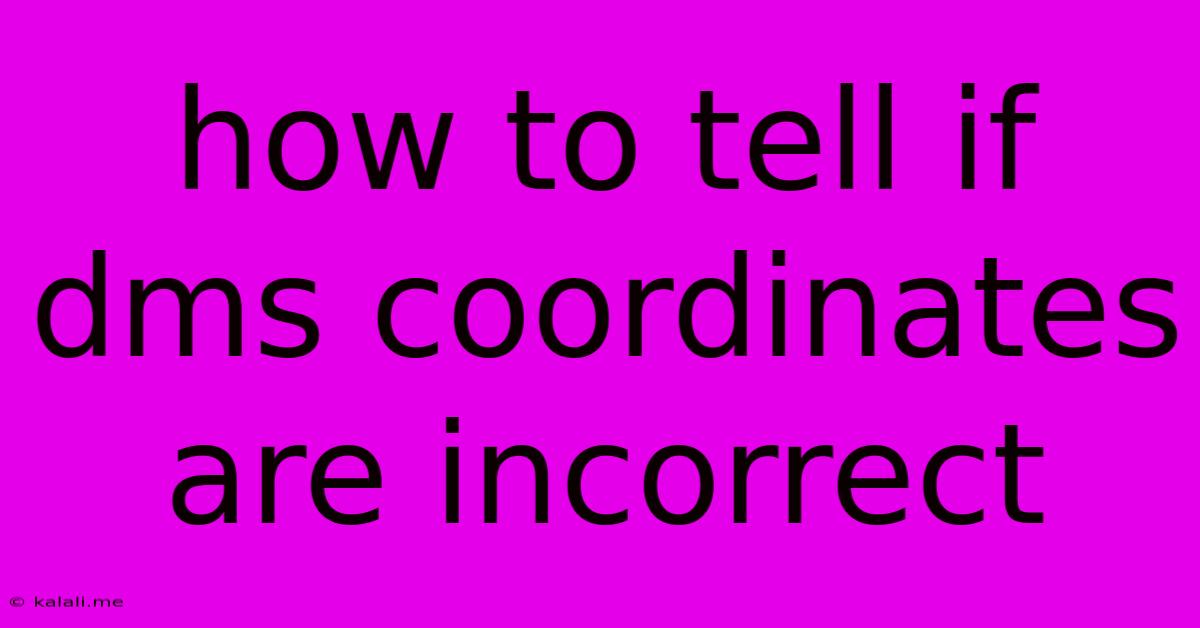How To Tell If Dms Coordinates Are Incorrect
Kalali
Jun 08, 2025 · 3 min read

Table of Contents
How to Tell if Your DMS Coordinates are Incorrect
Determining the accuracy of Degree-Minute-Second (DMS) coordinates is crucial for navigation, mapping, and various geographical applications. Incorrect coordinates can lead to significant errors, potentially resulting in wasted time, missed locations, or even dangerous situations. This article will guide you through several methods to verify the accuracy of your DMS coordinates. Knowing how to check your coordinates ensures you're working with precise geographical data.
Understanding DMS Coordinates
Before diving into verification methods, let's briefly recap DMS coordinates. They represent a location on Earth using degrees (°), minutes ('), and seconds ("). Each degree is divided into 60 minutes, and each minute into 60 seconds. DMS coordinates consist of latitude (North/South) and longitude (East/West) values. For instance, 34°05'12"N 118°14'30"W represents a location in Los Angeles.
Methods to Identify Incorrect DMS Coordinates
Several strategies can be employed to assess the accuracy of your DMS coordinates. These methods range from simple visual checks to employing advanced mapping tools.
1. Visual Inspection and Common Sense:
- Plausibility Check: Does the location described by the coordinates make sense in the context of your project or knowledge? For example, coordinates placing you in the middle of the ocean while you're supposed to be in a city are immediately suspect.
- Coordinate Range: Latitude values range from -90° (South Pole) to +90° (North Pole), and longitude values range from -180° to +180°. Coordinates outside this range are inherently incorrect.
- Decimal Places: Pay attention to the number of decimal places in the seconds component. Highly precise coordinates will have more decimal places than less accurate ones. Inconsistencies in the number of decimal places across your coordinates can indicate an error.
2. Using Online Mapping Tools:
- Google Maps/Google Earth: Input your DMS coordinates into the search bar of Google Maps or Google Earth. If the resulting location seems reasonable and matches your expected location, it increases confidence in your coordinates' accuracy. Discrepancies between the pin location and your anticipated location point towards an error in your DMS data.
- Other Mapping Services: Several other online mapping services (e.g., Bing Maps, MapQuest) offer similar functionality. Using multiple services adds a layer of verification. Consistent results across different platforms suggest greater accuracy.
3. Cross-referencing with Other Data Sources:
- Address Verification: If you have an address associated with your coordinates, try using online tools to convert the address into coordinates. Compare the resulting coordinates with your DMS coordinates. Significant differences might suggest an error.
- Existing Maps or Databases: Check if your coordinates match those on existing maps, geographical databases, or other reliable sources.
4. Understanding Potential Sources of Error:
- Data Entry Mistakes: Typos are a common source of errors. Double-check your DMS values meticulously.
- Data Transformation Issues: Converting coordinates between different formats (e.g., decimal degrees to DMS) can introduce errors if not performed accurately using appropriate conversion tools or formulas.
- Measurement Errors: The original source of your DMS coordinates might contain inherent inaccuracies due to limitations in the measurement methods used.
5. Advanced Techniques (for professionals):
- Geodetic Datum: Be aware of the geodetic datum used. Different datums can lead to slight differences in coordinate values. Using an inappropriate datum will result in coordinate inaccuracies. Ensure consistency in datum usage across your data.
- Coordinate Transformation Software: Specialized software can help transform coordinates between different datums and coordinate systems, improving accuracy.
By implementing these methods, you can significantly enhance your ability to detect incorrect DMS coordinates and ensure the accuracy of your geographical data. Remember that a multi-faceted approach, combining visual checks, online tools, and cross-referencing with other data sources, offers the most robust verification.
Latest Posts
Latest Posts
-
Smoke Coming Out Of Car Ac Vents
Jun 08, 2025
-
Does The Devil Have A Son
Jun 08, 2025
-
Wiring A Switch To An Outlet
Jun 08, 2025
-
Washing Machine Drain Hose In Wall
Jun 08, 2025
-
Can You Use A Gun To Stop A Kidnapping
Jun 08, 2025
Related Post
Thank you for visiting our website which covers about How To Tell If Dms Coordinates Are Incorrect . We hope the information provided has been useful to you. Feel free to contact us if you have any questions or need further assistance. See you next time and don't miss to bookmark.